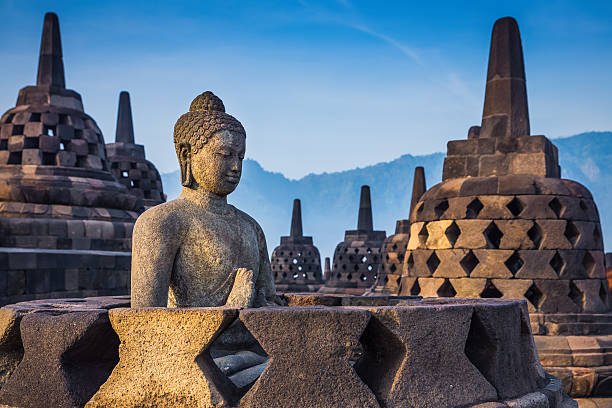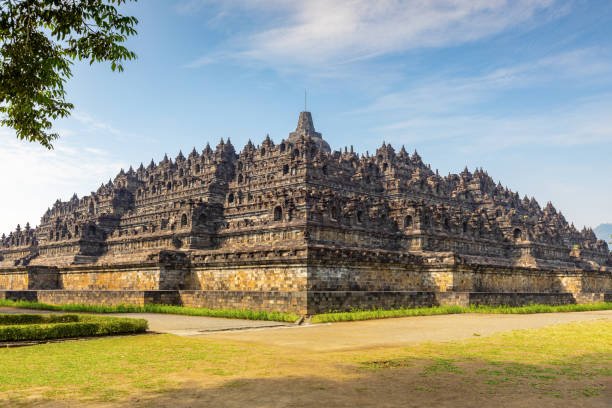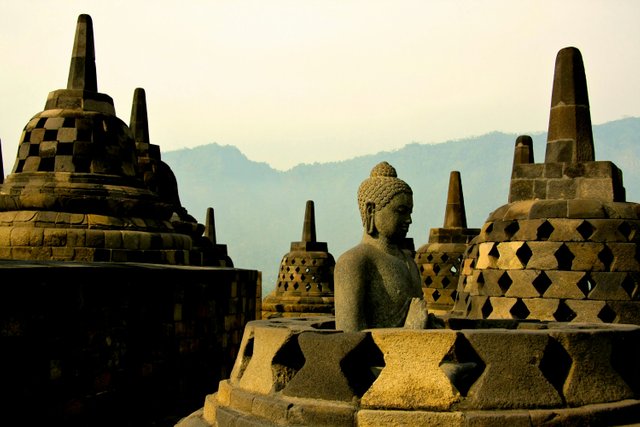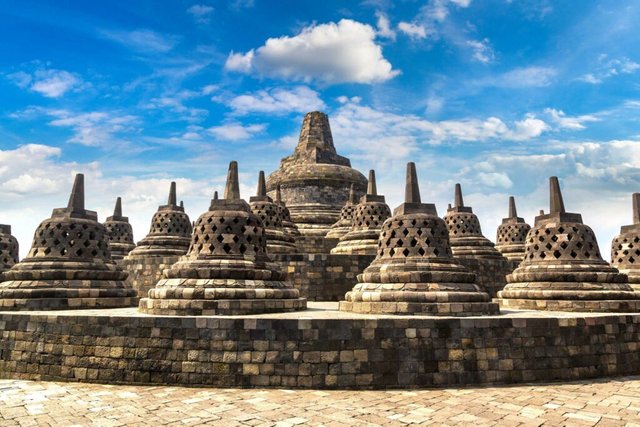History of Borobudur Temple
History of Borobudur Temple – The government's plan to increase ticket prices for the historical tourist attraction, Borobudur Temple in Magelang, Central Java has caused many pros and cons in society. The Coordinating Minister for Maritime Affairs and Investment (Marinves), Luhut Binsar Pandjaitan, announced that the latest rate to Borobudur for local people is IDR 750,000 per person.
The price is known to be 15 times higher than the current ticket price, which is only IDR 50,000 per person. Meanwhile, the government also plans to increase the rate for foreign tourists to US $ 100 or around IDR 1.4 million. Even so, students get a ticket price that is still quite affordable, namely IDR 5,000 per person.
The government claims that the plan is an effort to conserve or preserve historical sites. The increase in ticket prices will also be accompanied by the implementation of a limit on the number of tourists to around 1,200 people per day.
The plan to increase the entrance ticket price of Borobudur Temple as one of the important heritages of the Syailendra dynasty has also received comments from various history experts, one of whom is the Professor of History at UGM Jogja, Prof. Dr. Sri Margana, M. Hum. Sri Margana views that the increase in ticket prices is only a strategy by the government that does not want to lose. This is because the increase in rates coincides with the plan to limit the number of visitors on the grounds of preserving cultural heritage.
Borobudur Temple itself has a long history in the archipelago. This site is important historical evidence related to the development of Buddhism in Indonesia. Well, here is a discussion of the history of Borobudur Temple that Gramedia.com has summarized from various trusted sources. Let's see the review!
Discussing the origins and history of Borobudur Temple is known to contain a long story. Reported from the Cultural Heritage site of the Ministry of Education and Culture, Borobudur Temple is believed to have been first established in 750-842 AD by the government of the Syailendra Dynasty. The construction process of Borobudur Temple is estimated to have been carried out through mutual cooperation and step by step as a form of the goodness of Buddhist teachings.
Meanwhile, according to the Borobudur Conservation Center website, Historian J.G. de Casparis stated that the founder of Borobudur Temple was King Samaratungga who ruled in the period 782 - 812 AD, during the Syailendra Dynasty. Borobudur Temple was built to glorify Mahayana Buddhism.
However, according to the journal Pesona Candi Borobudur Sebagai Wisata Budaya Di Jawa Tengah by Reza Ayu Dewanti, Borobudur Temple was basically built as a form of glorifying the Syailendra kings (775 - 850 AD) who had reunited with the gods who were their origin.
History Peter Carey said that Borobudur Temple is a religious monument used as a place of contemplation. In addition, Borobudur Temple represents the journey of the Buddha and is a symbol of the relationship between a king and his people.
Until now, there are no written sources that mention when Borobudur Temple was founded and how long the construction process took. Determining when Borobudur Temple was founded is still the result of interpretation of the inscriptions dated which are believed to have been made in 824 AD. In addition, there is the Sri Kahulunan inscription which is estimated to have been made in 842 AD.
According to the Borobudur Conservation Center, the structure of the Borobudur Temple consists of nine terraced terraces and a main stupa at the top. The nine terraces consist of six square-planned terraces and three circular terraces. Based on legend, the architect who designed Borobudur Temple was a man named Gunadharma. However, historically this cannot be known for certain.
The construction process of Borobudur Temple took a very long time for hundreds of years until it was finally completed during the reign of King Samaratungga, 825 AD. Borobudur Temple was built in five stages. According to existing historical records, Borobudur Temple is a symbol of a universe.
The architectural form of Borobudur Temple which is in the form of a half ball represents the teachings of Buddhism, namely three levels in the universe, namely Kamadhatu which is filled with reliefs of humans with lust (the world of desire) and Rupadhatu which depicts humans fighting their lust (the world of form). Arupadhatu (the unformed world). Meanwhile, on the third level, Arupadhatu (the unformed world) no longer has decorations or reliefs as a form of being bound to the elements of the world.
The three levels can be seen on Borobudur Temple based on several existing reliefs. The existing reliefs are up to 3 meters long. In addition, there are 1,460 frames interspersed with several dividing planes of around 1,212 pieces.
At the top of the row of frames there is a kind of pleat that runs lengthwise and extends up to one and a half kilometers. This pleat itself has a decoration shaped like a series of lotus flowers.
In addition, at the top there is also a decoration with a triangular shape of 1,476 pieces. The kamadhatu and rupadhatu levels have 1,472 stupas and 432 Buddha statues that surround Borobudur Temple from all directions. Then, at the last level there are 72 stupas that surround the main stupa at the top.
Based on the Cultural Heritage site of the Ministry of Education and Culture, it states that there are several other interpretations that say that Borobudur Temple is not only based on Buddhism. The building of Borobudur Temple is believed to be greatly influenced by the concept of ancestor worship which is manifested in the form of terraced buildings.
Therefore, the temple, which is estimated to have required around two million pieces of stone to build, has many functions, starting from being a monument to glorify the ancestors of the founder of the Syailendra Dynasty and glorifying Buddhism.
Borobudur Temple is located in Borobudur Village, Borobudur District, Magelang Regency, Central Java Province. The splendor of Borobudur Temple itself was abandoned and lost due to being buried by soil and volcanic dust from the eruption of Mount Merapi.
Experts suspect that Borobudur Temple was abandoned due to the eruption of Mount Merapi around 1006 AD. At that time, King Mpu Sindok was focusing on moving the capital of the Medang Kingdom to the East Java region. It is not surprising that Borobudur Temple is estimated to have been abandoned around 928 AD and 1006 AD.
The relocation of the capital city caused the community to abandon Borobudur Temple. Until around 1365 AD, Mpu Prapanca in a manuscript entitled Negarakertagama which was written during the Majapahit Kingdom. The manuscript mentions "Vihara in Budur."
Over time until the 18th century, Borobudur Temple was no longer used. In many Javanese manuscripts, one of which is entitled Serat Centhini, the location of this temple is mentioned as a hill or place that can bring death or bad luck. This indicates that this place has been abandoned as a holy place for Buddhism.
Based on historical records, Borobudur Temple was rediscovered in 1814. At that time, Indonesia was still under British rule. Quoted from the Borobudur Conservation Center website, Sir Thomas Stanford Raffles, the British Governor General when visiting Semarang received information that in the Kedu area, rocks with pictures were found on the hills around Bumisegoro Village.
Furthermore, Raffles ordered a Dutchman named Cornelius to lead the cleaning of the site which was still covered by soil, bushes, and trees. Cornelius also invited 200 local people to cut down trees and cut bushes. The excavation was carried out for two months, only there were some parts that could not be excavated because they could collapse.
Starting in 1817, there were many small excavations carried out, but the results were never documented. Until 1835, the cleaning of the historical site of Borobudur Temple appeared after being continued by the Resident in the Kedu area named CL Hartman. Not only that, Hartman also conducted research activities on the site. However, the report related to the research was never published.
Historian and archaeologist and also the Second Head of the Restoration of Borobudur Temple, Soekmono stated in his book entitled One Century of Efforts to Save Borobudur Temple (1991), that efforts to photograph Borobudur reliefs had actually been carried out since 1845 by a photographer named Schaefer.
However, because the results of Schaefer's photos were considered unsatisfactory, the documentation of Borobudur reliefs was drawn directly by the hand of a soldier named FC Wilsen. Meanwhile, the writing explaining Borobudur was written by Brumund and edited and perfected by Leemans into an official monograph in 1873.
Based on information from the Borobudur Conservation Center, large-scale restoration of Borobudur Temple has been recorded as having been carried out twice. The first restoration was carried out by the Dutch East Indies Government under the leadership of Van Erp. Furthermore, the second restoration was carried out by the Indonesian Government led by Soekmono.
The discovery of carved rocks on the hill in the Kedu area is believed to be the former Vihara in Budur. This also attracted the attention of Raffles through his assistant, a Dutch engineer named Christian Cornelius. Until 1907 to 1911, an archaeologist and restorer born in Ambon, Theodoor Van Erp became the first person to carry out restoration on Borobudur Temple.
The funds spent by the Dutch East Indies government to carry out this first restoration of Borobudur Temple were estimated to reach 48,000 guilders. Van Erp began the work of restoring the first temple by collecting separate stones first. Next, he dug around the temple until he found many ornaments.
In 1908, the Dutch government approved an additional budget of 34,600 guilders to carry out a larger restoration. This restoration included the repair of the main stupa and the terrace stupa. Not only that, repairs to several corridor walls and balustrades (Rupadhatu) and repairs to the corridor were also carried out. This first restoration was completed in 1911.
In this first restoration, Van Erp had not touched on the increasingly dangerous slope of the walls. Van Erp focused more on repairing and leveling the floor of Borobudur Temple. According to the results of a study by the Borobudur Conservation Center, there was an unstable slope on the ground. This was due to too much water infiltration entering the base of the temple.
The second restoration of Borobudur Temple was carried out by the Indonesian Government and UNESCO from 1973 to 1983. The restoration, led by Soekmono, took about 10 years, starting on August 10, 1973. This colossal project was officially completed on February 23, 1983, with the dismantling of the Rupadhatu floor, installation of the reinforcing structure as the base of the corridor walls, cleaning and preserving the temple stones.
In 1955, as reported by the Cultural Heritage website of the Ministry of Education and Culture, the Indonesian Government submitted a request for assistance to UNESCO to handle the Borobudur Temple problem, especially related to the restoration. In 1955.
Then, UNESCO appointed an expert, namely Prof. Dr, P. Coremans, Head of the Laboratoire Central des Musees de Belgique. Coremans' arrival also had a significant impact on Borobudur Temple. Coremans stated that Borobudur Temple was suffering from "rock cancer". If not treated immediately, the temple's stones will slowly disintegrate.
In 1960, Borobudur Temple was declared in a state of emergency. UNESCO was finally more actively involved in efforts to preserve this historic site. Then, in 1971, a large-scale rescue effort was carried out on Borobudur Temple. UNESCO has officially approved the provision of restoration assistance for Borobudur Temple.
On February 23, 1983, the restoration of Borobudur Temple was declared complete. President Soeharto officially opened Borobudur Temple to the wider community. Previously, Borobudur Temple along with Pawon Temple and Mendut Temple were designated as World Cultural Heritage by UNESCO in 1991. The name Borobudur Temple Compounds was given by UNESCO to this historical site owned by Indonesia.
Over time, the development of Borobudur Temple has received increasing attention from the government. In 2008, the Borobudur Temple area was designated as a National Strategic Area. The determination of the National Strategic Area itself will be followed by a review and re-arrangement of the zoning of the area.



